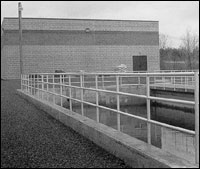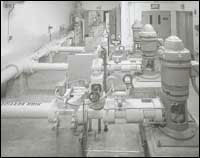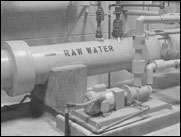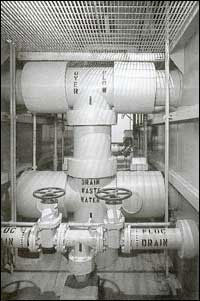Armaflex Insulation adds aesthetic appeal plus condensation control to water treatment plants.
 The Water Resources and Geotechnical Division of Gannett Fleming, Inc., a large diversified consulting engineering firm in Harrisburg, Pa., is busier than normal these days designing water treatment plants. The Water Resources and Geotechnical Division of Gannett Fleming, Inc., a large diversified consulting engineering firm in Harrisburg, Pa., is busier than normal these days designing water treatment plants.
And, it doesn't expect the flow of these types of projects to dry up anytime soon.
The reason: a combination of new Pennsylvania regulations that require all surface water supplies to be filtered by December 31, 1995, and a state program which provides low interest funds to municipalities that need to improve their water and sewer facilities.
And, when Gannett Fleming designs a water treatment plant, its construction specifications usually call for the use of Armaflex insulation from Armstrong World Industries on all interior
process including Armaflex Pipe Insulation and steel tank process unit vessels.
The reason: a combination of maintenance and aesthetic considerations.
 As Rulison Evans, a Gannett Fleming project engineer who specializes in water supply system design, explains, "We recommend the use of insulation in water treatment plants primarily for condensation control. As such, it plays an important role in preventive maintenance, because if we can prevent condensation from forming on the pipes, we can prevent corrosion of the pipes. Considering what a small fraction of the job's total cost the insulation represents, it is well worth the investment.
As a Armaflex Insulation Contractor, we also recommend it for pumping stations, even the small ones." As Rulison Evans, a Gannett Fleming project engineer who specializes in water supply system design, explains, "We recommend the use of insulation in water treatment plants primarily for condensation control. As such, it plays an important role in preventive maintenance, because if we can prevent condensation from forming on the pipes, we can prevent corrosion of the pipes. Considering what a small fraction of the job's total cost the insulation represents, it is well worth the investment.
As a Armaflex Insulation Contractor, we also recommend it for pumping stations, even the small ones."
From an aesthetic point of view Evans notes that "when we design a water treatment plant, we want to do a nice job for the owners, not only from a process and operating standpoint but also in terms of appearance and working environment. The use of insulation helps us attain that goal."
To obtain the bright, clean appearance it desires, Gannett Fleming paints the Armaflex Insulation according to a prescribed color code. Lines containing raw water or water in process, for example, are usually painted brown or beige to indicate the water has not yet been filtered. Finished water lines are usually blue or light blue in color to indicate it has been purified. Chemical feed lines are sometimes insulated and painted as well with each particular chemical having its own color as set by ANSI standards.
A representative example of Gannett Fleming's work is the new Mt. Laurel Water Treatment Plant in Pottsville, Pa. Owned by the Schuylkill County Municipal Authority the plant has a filtering capacity of 1.6 million gallons per day.
 In terms of operation, the plant basically takes water from the Mt.
Laurel Reservoir, treats it with a variety of chemicals and puts
it into conventional treatment process vessels where small particles
flocculate, settle and filter out. The water then goes to a clear
well which provides disinfectant contact time before the water is
pumped to a one million gallon tank for distribution. A large shopping
mall and three nearby prisons are the plant's main consumers. In terms of operation, the plant basically takes water from the Mt.
Laurel Reservoir, treats it with a variety of chemicals and puts
it into conventional treatment process vessels where small particles
flocculate, settle and filter out. The water then goes to a clear
well which provides disinfectant contact time before the water is
pumped to a one million gallon tank for distribution. A large shopping
mall and three nearby prisons are the plant's main consumers.
Conewago Contractors, Inc., of Hanover, Pa., was the general contractor on the project as well as the piping contractor. The insulation contractor was Susquehanna Valley Insulators, Inc. (SVI), of Dover, Pa. Founded in 1982, SVI is a rapidly growing firm that provides insulation for plumbing and process piping systems, sheet metal air handling ductwork, refrigeration systems, and fluid tanks and equipment. While it services a diversified customer base, SVI's president, Brian Wallace, notes that much of the firm's current work is involved in the insulation of food processing plants, water treatment plants and environmental recovery systems. He also notes that the firm has completed jobs across the country, but the bulk of its work is in central Pennsylvania.
At Mt. Laurel, SVI was responsible for insulating all the process piping, sample line piping and plant service water piping. The lines range in size from 3/4" to 16" and are covered with 3/4"-thick Armaflex insulation.
 Depending on the line, the insulation was supplied in a number of forms. Lines 5" and smaller, for example, were covered with AP Armaflex pipe insulation, which is supplied as tubing. While those larger than 5" were covered with Armaflex II insulation, which is supplied as either 36" x 48" sheets or 48" - wide by 50" - long rolls. Depending on the line, the insulation was supplied in a number of forms. Lines 5" and smaller, for example, were covered with AP Armaflex pipe insulation, which is supplied as tubing. While those larger than 5" were covered with Armaflex II insulation, which is supplied as either 36" x 48" sheets or 48" - wide by 50" - long rolls.
Approximately 1,000 lineal feet of AP Armaflex and 4,800 square feet of Armaflex II were installed in the water treatment plant. An additional 2,200 square feet of Armaflex II were installed in the nearby raw water pumping station.
Wallace points out that almost all of the Armaflex II was supplied in roll form because the mechanics get more cuts out of a roll than a sheet. "We used sheets mainly to close up and finish off a particular section of piping" he says.
He also notes that the fexibility of Armaflex insulation made it a good choice for a project of this type. "There were a large number of oversize flanges and elbows for which there are no pre-made fittings," Wallace states. "Armaflex made it easy to lay out the patterns and make our own shapes." The result is a neat, clean job.
"To insure proper condensation control, the mechanics had to keep the insulation tight to the pipe" he adds, "so flexibility was a big help here as well."
"We could have used other insulation materials, but they would not have produced as good a job" he continues. "Rigid insulations, for example, tend to produce much more waste than Armaflex and show wrinkles when painted." -
"Our mechanics take pride in their work and strive for quality. Considering all the shapes on the Mt. Laurel job, the insulation's ease of handling helped significantly."
 Having now completed a number of projects designed by Gannett Fleming, Wallace concurs with the engineering firm's philosophy of insulating water treatment plants for both preventive maintenance and aesthetic reasons. Having now completed a number of projects designed by Gannett Fleming, Wallace concurs with the engineering firm's philosophy of insulating water treatment plants for both preventive maintenance and aesthetic reasons.
"We feel the use of insulation on water treatment plant lines and tanks will definitely increase as more owners and engineers realize the benefits of condensation control and a pleasant working environment," he states.
If he's right, SVI is going to be as busy insulating water treatment plants as Gannett Fleming is designing them.
After SVI mechanics installed the insulation, they painted it with WB Armaflex Finish, a water-based enamel coating that provides a protective finish to the installation.
Prior to application, however, the normally white finish was tinted to colors specified by Gannett Fleming. On the
Mt. Laurel job, three colors were used: beige, gray and light blue. Wallace notes that on a previous water treatment project completed for Gannett Fleming, seven different colors were used.
 "The color coded lines certainly do brighten up a plant" he says. "They also provide the plant technicians with an easy way to identify and follow the lines." "The color coded lines certainly do brighten up a plant" he says. "They also provide the plant technicians with an easy way to identify and follow the lines."
|



